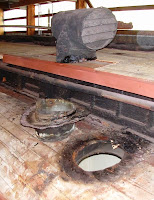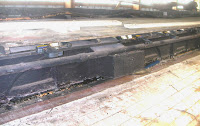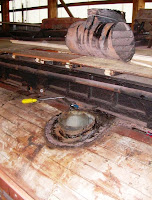By now I'm sure you've all heard that the 1630 passed its hydro test yesterday. This is great news for the Museum, and congratulations to the Steam Team who have worked so long and hard to make it happen. Afraid we don't have anything nearly so exciting to report here, but keep reading anyway.
A lot of the work today was more of the same. All the tacks in the flashing at the top of the lower canvas have to be pulled, and they're spaced between 3/4" and 1" apart, so there's hundreds of them. And they're coated with a thick layer of tar, but with practice they can be removed at a reasonable pace.
And there was more woodwork on the upper roof. I'm letting the glue dry until Saturday, and then the last section of molding can be installed. And I did more planing and sanding on the lower tack molding, followed by painting.
A space was opened up so the scaffold can be placed at the east end of the car (#1 end) and I started removing the canvas and tack molding.
It may not be obvious, but here the tack molding is partly removed from the end. And the next corner piece is ready to be fitted.
Now for something completely different. In the late afternoon, I helped Rod load a pair of PCC trucks onto a flatbed for shipment to Mt. Pleasant. Our buddies there have acquired a PCC from Philadelphia Pittsburgh, and it will be arriving tomorrow. Its trucks need to be regauged, so in the meantime we're letting them borrow a pair of CTA trucks so they have something to put the body on.
First the trucks had to be lifted out of the mud in the rain. And then they were loaded onto the flatbed and chained down.

And by nightfall the driver was on his way back to Iowa.
So this was a welcome break from pulling tiny tacks.
Meanwhile, our other roof projects in Barn 4 are all making progress.
The tireless Tim Peters is applying black canvas paint to the 24.
The Michigan car has a first coat of canvas paint.
And the LSE freight trailer is ready for its first coat of canvas paint. This plastic covering around the whole car is what I will need to do on the 319, since I need to protect the nice paint job. Canvas paint is thin and tends to drip no matter how careful you are.
Work does not stop at IRM over the winter, unless the snow is so deep that nobody can get in or out. Come on out and see for yourself. There are always plenty of projects needing help.























































